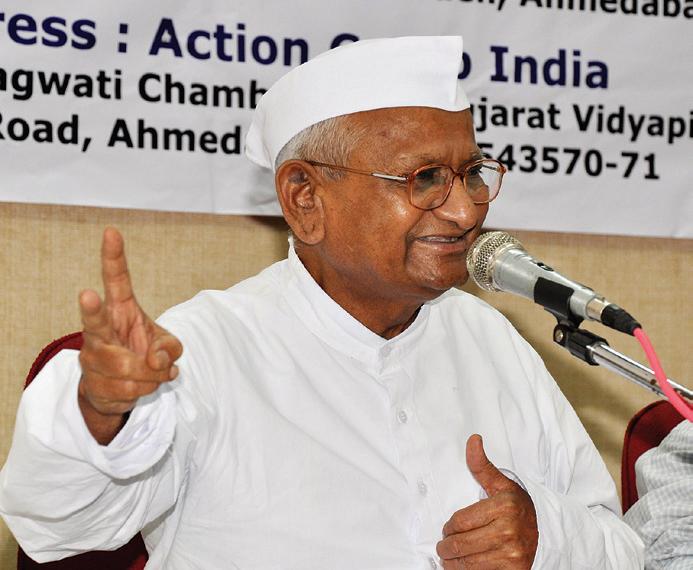
3 minute read
New nationalism
from 2011-09 Sydney (1)
by Indian Link
BY SREEDHEVI IYER
It’s been a saga worthy of the Ramayana itself. A single man’s epic spiritual pilgrimage for the sake of truth, for the sake of justice.
One could have used these words to describe Mahatma Gandhi in the 1940s. The words are now in vogue again, for a gentle, soft-spoken, non-descriptive man called Anna Hazare.
How does one account for his sudden popularity in the past few months? He isn’t the first citizen to fast for an end to government corruption – Baba Ramdev, a well-known spiritual guru, attempted the same, but without any repercussions. Irom Sharmila, a lady in Manipur, has been on an 11-year fast for the repeal of the Armed Forces Special Powers Act, which has yet to occur. So what makes the Anna Hazare movement any different?
The media spotlight comes with its own inherent powers. Once a story is angled right, desired results are instantaneous. The Gandhi parallels are almost too delicious to ignore. But they work only because the disillusionment of the average Indian with its government is so rife and rampant, so much now a part of the Indian DNA (and which gave Amitabh Bachchan a roaring career in the ‘70s) that it is no longer a leap of logic to believe the Indian citizen lives under an undemocratic, oppressive regime.
BrisVaani is a local radio station in Brisbane. It runs 24 hours a day, and services the Indian community through request programs, newscasts, traffic reports, and Bollywood songs. For the past month, every programme that has had a live deejay has mentioned Anna Hazare, in progressively reverent tones. His movement is reiterated in Hindi, Tamil, English, Sinhalese…. The name, like the man, has caught the Brisbane Indian’s imagination. The question remains though – these Indians now work, live, and pay taxes in Australia. Why would a hunger strike happening thousands of miles away, garner news in a local community station?
Varad Raval of BrisVaani feels the strongest involvement comes from the first-generation of Indians, those who had arrived in Queensland in the ‘60s and ‘70s – and possibly even the newer arrivals of the past few years. “These are the ones who have experienced the corruption in India,” he says. “The first thing you think of when you say ‘India’ is population. The second, is corruption.”
Anna Hazare’s projection of his personality as a Gandhian involved in a non-violent movement is another factor in his diasporic appeal. A community that is nostalgic of its roots, will latch on to such iconic symbols of patriotism quite easily. “There was a time when the Gandhian way was out of date,” says Varad. “But now, with things like the Munnabhai movies capturing public imagination, the idea has been updated. (Anna Hazare) is a softspoken, gentle man speaking of the second war of independence!” Strong words from a quiet man, an appealing contrast indeed.
The question still remains, though – has this man’s victory been a simplistic one? Has a complex issue been reduced to patriotic oneliners in order to access the broadest possible audience – after all, you can’t have people power without the people themselves? Anna Hazare isn’t without his naysayers. Salil Tripathi writes in im4change that the Hazare adulation is misguided – the man who reformed his own village included whipping as punishment for imbibing alcohol. Gandhi fasted as a method of self-purification, including when people in his ashram behaved deplorably. It is hard to imagine the Mahatma routinely fasting in order to impose his own will against a democratically elected government. And now, Anna Hazare says the victory is half-won – and there further demands for referendums will be made –hinting at future fasts, future passive-aggressive impositions.
The complexities of such things are most possibly lost on the diasporic Indian, viewing the homeland as the repository of a cultural utopia. “There is a lot of sentiment attached to this movement,” agrees Varad. “The nostalgia is there – the Indians here want a corruptionfree India.” A sentiment that is easier said than done.
In the end, the Anna Hazare movement is symbolic for things that are bigger than the man, and possibly bigger than the movement itself. For decades, the Indian vote bank had been its lower classes, both the rural farmer and the urban labourer choosing party members that aren’t much cleverer than themselves.
The Indian middle-class, characteristic in its political apathy and crass consumerism, neither contributed nor were consulted. But with the rest of the non-western world becoming politicised and seeking reform, perhaps an infectious spark has been lit in Delhi. It is the middle-class Indian who is not only weary of the corruption, but suddenly savvy enough to want a clean, viable alternative that doesn’t involve migrating to places like Australia.
The new Indian wants to dig his heels in and demand a change on home soil. Whether this is a new war of independence or not, this is definitely a new kind of nationalism, forming itself as we watch.










